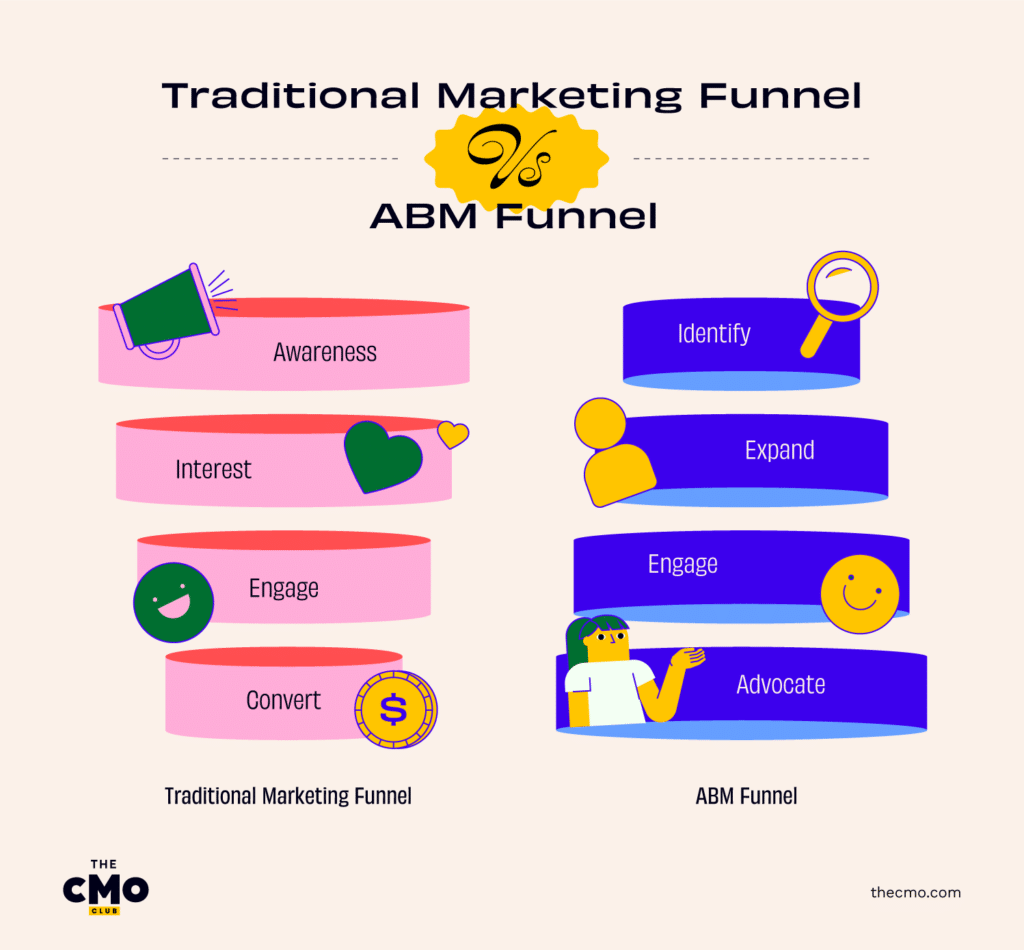So, you want to implement account-based marketing (ABM) in your organization—now what?
ABM has proven to be a game-changer, especially for B2B marketing. Before you begin, you’ll want to identify which type of ABM is right for your business. Whether it’s Strategic ABM, ABM-Lite, or Programmatic ABM, the type of ABM you decide on will determine the next steps of rolling out your program.
And so, I'll explain what each version's best use case is, the benefits, and how to ultimately select the right type for you. Keep reading to understand the nuances of each type of ABM and which one will best suit your business.
What Is Account-Based Marketing (ABM)?
Account-based marketing is a strategic marketing approach that specifically targets high-value prospects. The idea is to invert the traditional marketing funnel to create a new ABM funnel that prioritizes the identification of high-value accounts and to design your marketing initiatives to appeal to a specific business or individual.

In order for your ABM efforts to be effective, you must create relevant content based on the data gathered through ABM analytics about each prospect.
Types Of Account-Based Marketing
Strategic ABM
Strategic ABM, also known as one-to-one marketing, is ABM in its most traditional sense, prioritizing the identification of high-value accounts and crafting personalized marketing assets designed to engage a particular set of decision-makers, driving revenue growth. This is the most personalized and targeted form that it can take.
ABM Lite
ABM Lite, also known as one-to-few marketing, is a slightly broader version of the traditional ABM strategy, where marketing teams create semi-customized campaigns designed to appeal to a group of accounts that share common traits or challenges.
Programmatic ABM
Programmatic ABM, or one-to-many marketing, is an approach that leverages technology and automation to target a higher number of accounts while still maintaining a level of ABM personalization. Think of it as the most zoomed out version of ABM, while still maintaining the targeted marketing approach.
Benefits Of Account-Based Marketing By Type
Strategic ABM
Strategic ABM centers the relationship with each individual account, strengthening these relationships and garnering more of their business. This type of ABM is considered the best for building trust and long-term business relationships, ultimately boosting your bottom line.
ABM Lite
Taking an ABM Lite approach to inbound marketing offers superior scalability across multiple accounts, ideal for optimizing efforts without compromising quality or reach. It's the best option for maximizing your return on investment.
Programmatic ABM
With Programmatic ABM, you can keep ABM personalization in your marketing efforts while still catering to a broad audience. This data-driven marketing strategy is best for extensive outreach to your ideal customer and the optimization of campaigns through real-time performance insights.
Challenges Of Account-Based Marketing By Type
Strategic ABM
Strategic ABM is arguably the most resource-intensive type of ABM, and takes a considerable amount of effort to pull off successfully. From identifying your target account list to data collection and analysis, and finally creating campaigns that speak to key stakeholders, there’s a lot of room for error.
ABM Lite
ABM Lite presents its own set of challenges, like finding the sweet spot between personalizing your marketing through targeted content while still appealing to all of the accounts you’re attempting to target. Identifying the right accounts requires a deep understanding of the market landscape and customer base, making collaboration between sales and marketing teams paramount to your success.
Programmatic ABM
While the power of marketing automation and technology is alluring, integrating new tools into your existing MarTech stack can be a challenge. It can also be difficult to achieve the type of personalization that moves the needle on your marketing efforts and to tailor your messaging in a way that appeals to your target audience with diverse needs and challenges without alienating accounts.
Account-Based Marketing Tactics By Type
We’ve put together a list of tried and true tactics for each type of ABM to get you started on the right foot.
Strategic ABM
- Personalize your sales pitch according to your target accounts' needs, challenges, and goals to demonstrate a deep understanding of their business and offer relevant solutions.
- Send personal video messages to your target accounts, addressing the recipient by name and discussing their company's specific challenges.
- Initiate an IRL meeting to open up the channels of communication and strengthen the relationship between your businesses.
ABM Lite
- Build tailored landing pages to address the unique pain points, interests, and needs of specific account clusters.
- Create case studies featuring client success stories within a specific account cluster, showcasing how your product or service has effectively helped similar businesses overcome common industry challenges.
- Host workshops or roundtable discussions for representatives from the target account cluster, providing networking opportunities and a platform to exchange industry insights, discuss shared challenges, and explore potential solutions in a collaborative setting.
Programmatic ABM
- Use website personalization tools to create custom content tailored to each target account's industry, company size, or other key attributes, enhancing ABM engagement, lead generation, and conversion rates through personalized customer experiences.
- Leverage multiple marketing channels like email, paid social media ads, advertising, and content marketing to create a cohesive experience for your target accounts.
How To Choose The Right Type of ABM
Selecting the right type of ABM is key to generating the results you want, so choose wisely! Let’s explore key factors to think about:

1. Consider company size and resources
Whether your business is a SMB or a large enterprise, ABM can be an effective strategy for you—provided you choose the right type. The size of your organization and the amount of resources at your disposal will play a key role in deciding which type of ABM is right for you.
- Strategic ABM is a great solution for enterprises capable of investing in their marketing strategy, enabling targeted campaigns for key accounts to maximize ROI within time and budget constraints.
- ABM Lite suits SMBs aiming for significant impact without excessive costs, allowing efficient outreach to multiple accounts for enhanced results at an affordable price point.
- Programmatic ABM is ideal for B2B companies seeking to amplify their account-based marketing efforts, leveraging automation and technology for cost-effective, scalable campaigns.
2. Evaluate your target accounts and customers
Who are your customers and what do they want? Identifying your ideal customer profile will give you a clearer idea of the type of ABM strategy that will make an impact.
- Strategic ABM is a good option if you’re targeting large enterprises with multiple stakeholders and complex sales cycles. Crafting tailored marketing campaigns for these businesses enables you to cut through the noise and stand out from the competition.
- ABM Lite may be the right choice if you’re looking to appeal to small-to-medium-sized businesses through marketing assets that are tailored enough to make an impression but still relevant for a wider audience.
- Programmatic ABM is the one-size-fits-all of ABM. By leveraging technology, businesses can adapt to the ever-changing landscape of digital marketing and maintain a hands-on, personalized approach that’s scalable.
3. Define your ABM strategy, goals and objectives
Before selecting an ABM strategy, it’s important to get clear on your goals and objectives. Aligning your account-based marketing strategy with your company’s overarching goals can help you choose the right type of ABM for your organization.
One pro tip for getting leadership buy in with your ABM strategy: Use ABM statistics to show the value of including this strategy in your marketing mix.
4. Assess marketing and sales capabilities
The effectiveness of your marketing endeavors hinges on the capabilities and collaboration between your marketing and sales teams. For account-based marketing in particular, synergy between both sides is the best way to ensure mutual success.
- Strategic ABM campaigns epitomize the synergy between sales and marketing, navigating towards success with precision and personalization. Strong project management skills are essential for aligning sales and marketing efforts effectively.
- ABM Lite serves as a potent collaboration tool, harmonizing sales and marketing teams to target more customers through personalized and scalable strategies.
- Programmatic ABM demands marketing experts with a blend of analytical and technical prowess, coupled with the flexibility to customize account-based marketing campaigns based on data-driven insights.
5. Consider your tech stack and options
The technology and resources available to you play a critical role in the success of your ABM strategy. With so many different automation tools and account-based marketing software solutions on the market, it can be daunting to determine which is worth investing in, and how this technology will integrate into your existing tech stack.
- Strategic ABM campaigns can be challenging, requiring the right tools, platforms, and tactics alongside personalized messaging to capture the attention of target companies and track ABM metrics effectively.
- ABM Lite strikes a balance between automation and CRM systems, allowing for highly targeted outreach efforts without compromising quality.
- Programmatic ABM harnesses advanced technology, such as programmatic advertising platforms, website personalization tools, and predictive analytics software, to elevate your campaigns with data-driven strategies.
Join For More Account-Based Marketing Insights
Choosing the right ABM strategy (and abiding by our top ABM best practices) is crucial for driving success in your marketing efforts. While selecting the right type of ABM may seem overwhelming, here are three takeaways to keep in mind:
- Understanding the differences between Strategic ABM, ABM Lite, and Programmatic ABM is essential to finding the right fit for your business.
- Factors like company size, target market, and goals are important to consider when selecting an ABM strategy.
- Collaboration between marketing and sales teams is crucial for the successful implementation of any ABM approach.
With this information in hand, you’re already well on your way to wooing your top prospects. Check out which common ABM mistakes to avoid next!
Want to learn more about ABM and the benefits of personalized marketing? Then you’re definitely going to want to subscribe to The CMO newsletter.


